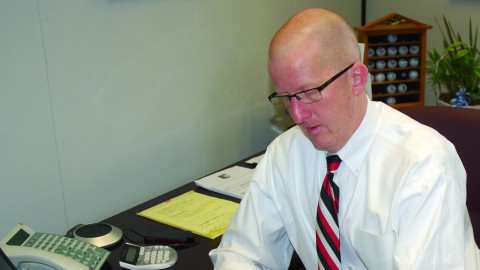By Liam Bouquet

Compared to admission statistics at this time last year, Youngstown State University has experienced a significant increase in the number of freshmen who have applied and been admitted to the university for the 2015 fall semester.
Comparing Feb. 24, 2015 to Feb. 25, 2014, the statistics found a 121 percent rise — or a 3,272 student increase — in students who have applied and a 66 percent rise — or a 1,438 student increase — in students who have been admitted.
In addition, the number of scholarships awarded has increased by 751, out-of-state admissions have increased by 295 students, the average GPA of admitted students has increased from 3.03 to 3.23 and the average ACT has increased from 20.77 to 21.37.
Martin Abraham, YSU’s provost, listed a number of factors that have helped bolster enrollment statistics, including the university’s 2014 decision to hire on Royall & Company, a third-party enrollment manager, to combat sinking enrollment.
“First and foremost, we hired Royall & Company, which is the recruiting firm that we have been working with; they have put in a lot of effort in terms of streamlining our process and getting us the contact information for prospective students,” Abraham said. “Gary Swegan has been doing a great job of getting the word out to students. … The president has been busy visiting high schools all over the area. All of these have added to the growth in the enrollment. Then the other piece, that has been happening for a number of years, YSU is just doing a better job getting the word out about the quality of the education that we can provide.”
Gary Swegan, the associate vice president of enrollment and management, agreed with Abraham.
“[Royall & Company] are able to do marketing that we simply don’t have the person power to do, … to continue to contact the student time after time after time,” Swegan said. “When I got here 15 months ago, all I ever heard, whether it was a faculty and staff member or a member of the community, was, ‘My students just hardly ever heard anything from YSU.’ Now what we are hearing is, ‘Oh my gosh just leave us alone.’ … I would much rather have somebody say, ‘Okay I’m not interested stop contacting me than be interested and not be getting any information from us.’”
Swegan made it clear that although this increase in admitted students is a good sign, he was still focused on the bottom line: enrollment.
“We still have a lot of work to do,” Swegan said. “We have set a goal to be up at least 20 percent in incoming undergraduate students. So what does that mean? We had 1,734 freshmen last year; we would like to have 2,100. We had about 560 transfers; we would like to have 675. … Really my message to my entire team is that it is all about who we get to commit and not about who we get to fill out a piece of paper.”
As of now, it is unclear to what extent these improved statistics will impact enrollment. Swegan pointed out that as YSU accesses a wider body of students in a wider area, a higher rate of admitted students are likely to choose not to attend.
“It is harder for us to close the deal as you get outside of our traditional footprint and students know less about us — and they are coming from a distance where they might be expecting to live on campus and we have got a fairly limited number of spaces — then it becomes harder for us to yield them. So yes they can fill out the applications, but certainly as you get further and further away from campus, you would expect, a smaller percentage of those students would actually choose us,” he said.
Swegan is hopeful however that these enrollment goals will be reached — pointing to an increase in students who have preregistered for EARLY-SOAR, an early orientation and registration program in March.
“Probably most importantly, through yesterday, we were up about 23 percent preregistrations for the early SOAR program. So we are really putting a lot of focus particularly on the early date. The first three SOAR dates are this Saturday, next Tuesday and next Wednesday. And I expect the first three programs to have brought in almost 100 more students than the first three programs last year,” he said. “That will be just the beginning, you know, because we want to be up 350 to 400 students.”
Swegan said these improved admission statistics, and the potential enrollment increase, are not likely to save the university from its financial troubles, but the university is trying to develop an enrollment strategy that will have much greater returns down the road.
“When you have four straight years of down and you bring one class in that is big, you still have smaller classes in front of it. Our goal would be a much larger incoming first year class that would allow us to, I would say, stop the bleeding and maybe even get the needle turning back in the right direction in the overall enrollment. … If you do that two years in a row, now you really start to see some momentum and that overall enrollment will incline exponentially,” Swegan said. “There is never any guarantee, but I think what we are building right now is sustainable.”


